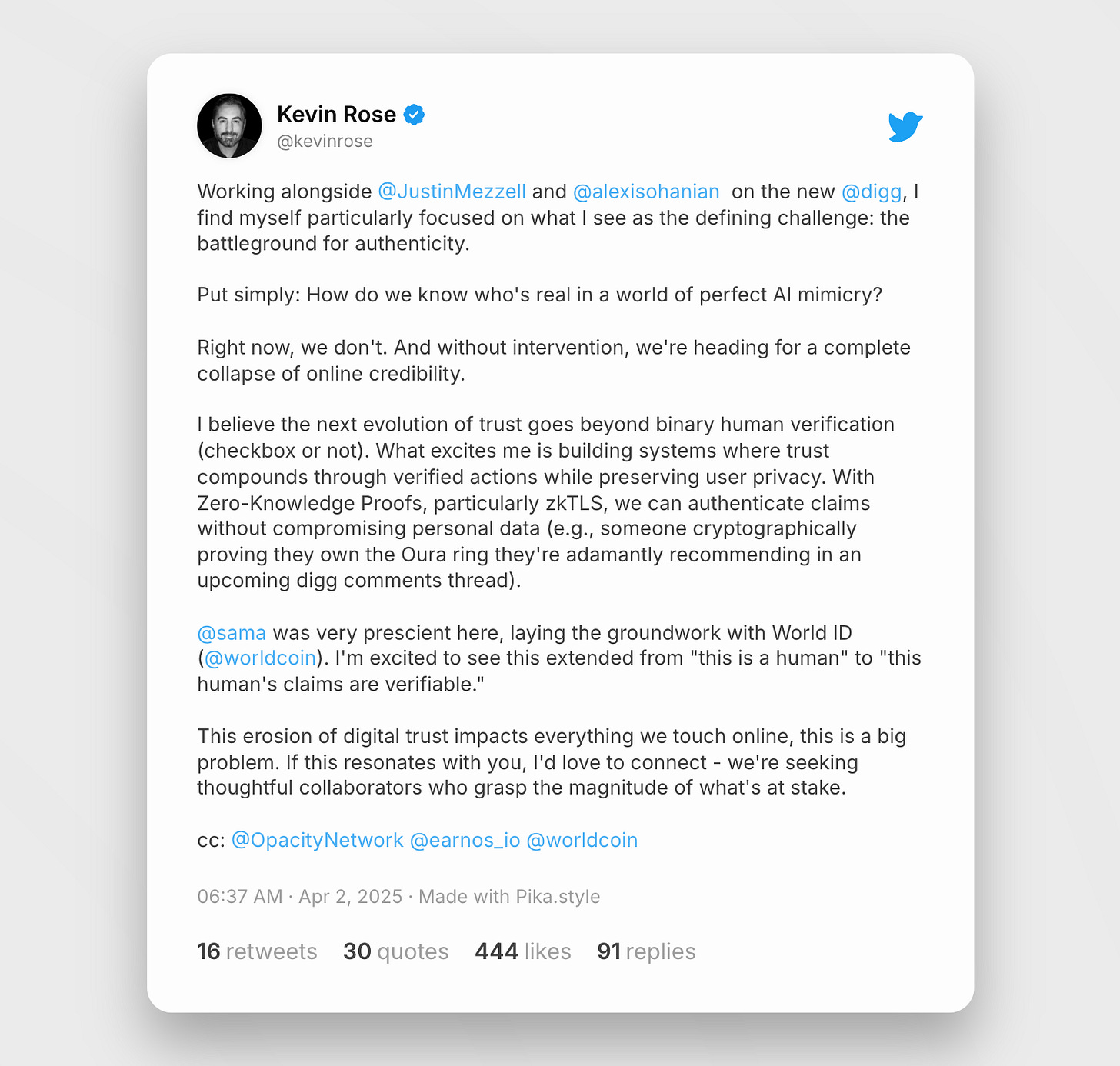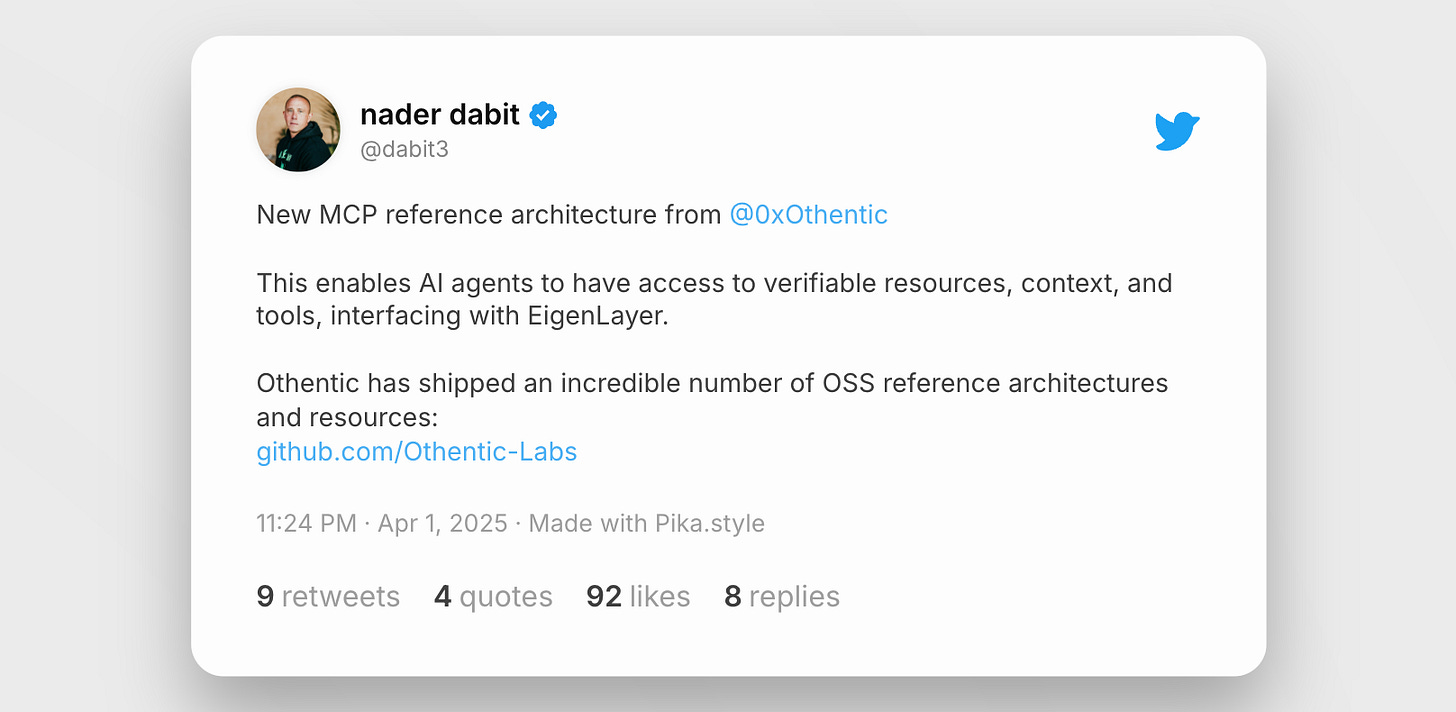Re:Staking Weekly #21
Slashing Goes Mainnet, Digg is Using Opacity's zkTLS Service, Layer's WAVS Framework Launch, and Eigen Summer Fellowship
Welcome to Issue #21 of Re:Staking Weekly! 👋
Slashing is going mainnet — you heard it right. This week we start off with the highly anticipated slashing mainnet release, which will happen on April 17th. We break down the importance of this major achievement and what's likely to unfold afterwards — will the adoption of slashing be swift or gradual, similar to the pattern observed during the rewards v2 rollout?
Also in this issue: Digg is using Opacity's zkTLS service, restaking risk research by P2P.org and TokenSight, Layer's WAVS framework launch, Eigen Summer Fellowship, and more.
Let’s get into it! 🚀
Slashing Goes Mainnet, What’s Next?
EigenLayer’s highly-anticipated slashing feature is set to launch on Ethereum mainnet on April 17th. This launch represents the final major milestone in the restaking protocol, placing restakers’ assets at genuine risk for the first time.
The heightened anticipation stems from the expectation that placing assets at risk will incentivize AVS projects to significantly increase reward issuance, thereby igniting the economic engine of restaking and accelerating protocol adoption. The critical question now is whether this new slashing mechanism will experience rapid adoption or if it will mirror the slower, incremental uptake observed with prior features like reward distribution.
The Optimistic View on Slashing Adoption
From EigenLayer's perspective, internal sources cautiously predict a potentially slow initial adoption, acknowledging that slashing represents a significant responsibility for many nascent AVSs. Su, EigenLayer's senior business development manager, emphasizes,
"We do not expect all AVSs to adopt slashing immediately or all at once. This process will likely unfold over time as AVSs gradually implement it into the protocol."
Nevertheless, there are strong reasons to be optimistic about adoption. A detailed review of EigenLayer’s slashing upgrade highlights that while both old and new slashing systems will coexist, the new mechanism represents a fundamental shift with substantial changes to user experience, incentive structures, system interfaces, and APIs. Consequently, AVS teams will likely find themselves compelled to adopt the new design, driven both by updated EigenLayer user interfaces and growing demand from ecosystem participants.
This is excellent news. Initially, I thought both slashing mechanisms would operate side-by-side indefinitely, with no clear guidance or incentives to transition. However, it now seems clear that once the new slashing mechanism goes live, adoption of this improved model will likely exceed expectations.
Key Changes in the Slashing Model
The most significant change is in how operators allocate restakers’ funds to AVS projects. Previously, operators could double-count the same assets as they are non-slashable, meaning a single pool of funds could be simultaneously delegated to multiple AVSs. This inflated the TVL figures, creating misleading incentives and inaccurate measures of AVS popularity and strength.
The new slashing model entirely eliminates this problematic double-counting. When operators designate a portion of restaked funds as slashable for a specific AVS, those funds will count exclusively towards that AVS alone. As a direct consequence, we should expect a substantial decline in reported TVLs for many AVSs, with figures now accurately reflecting genuine operator confidence and the true comparative advantage of each AVS.
What to Expect from Now
This shift will inevitably pressure AVSs to offer clearer, more substantial incentives. The era of easy or "free" liquidity for AVSs is likely coming to an end. Although practices like airdrop hunting and rewards farming will continue, these decisions will become far more rational and economically driven. Unless AVSs provide compelling reasons — whether through credible token airdrop potential or tangible rewards — their TVLs will likely decline significantly or stagnate at negligible levels.
For restakers and broader ecosystem participants, this development represents a highly positive turning point. With EigenLayer’s feature set now complete, market dynamics can finally shift toward healthier, more transparent incentives. Personally, I'm very optimistic that the mainnet launch of EigenLayer’s slashing feature will address past negative sentiment and align ecosystem incentives in a significantly better direction. Moving forward, we'll monitor adoption closely and provide detailed insights into the real-world impact of these changes.
News Bites
Watch Jordan’s video on why verifiability is essential in the era of agentic AI — and how EigenLayer plays a key role in enabling it.
TokenSight and P2P.org just published a study analyzing restaking risks and outlining approaches to quantify them.
Layer launched its WebAssembly-based AVS Builder, making it easier and faster for developers to stand up new AVSs.
Mellow Protocol — a restaking-based vault platform — is launching soon on EigenLayer.
ARPA, the only AVS consistently rewarding outside of EigenDA, is now Rewards v2 compliant and kicked off its Season 4 rewards on April 3.
Big news this week: Kevin Rose’s rebooted Digg is tapping into zkTLS via EigenLayer’s AVS, Opacity.
Othentic unveils its AVS MCP implementation, giving agents seamless access to verifiable services via a standardized interface.
EigenLayer has launched its Summer Fellowship — an 8-week paid builder program offering direct guidance from EigenLayer CEO Sreeram, Nader Dabit, and Gajesh.
That's it for this week's newsletter! As always, feel free to send us a DM or comment directly below with your thoughts or questions.
If you want to catch up with the latest news in the restaking world, give our curated X list a follow!
See you next week and thanks for reading,












